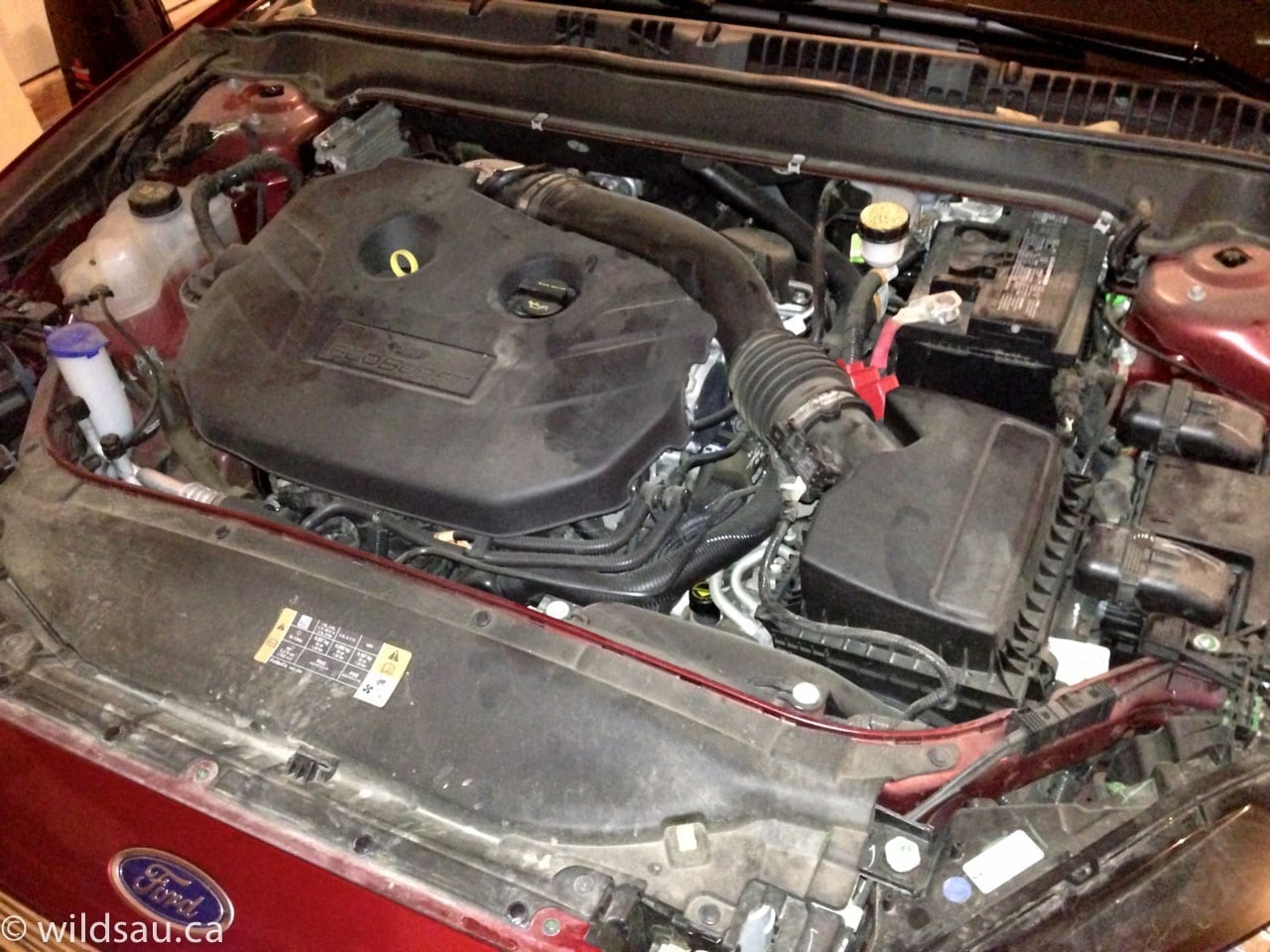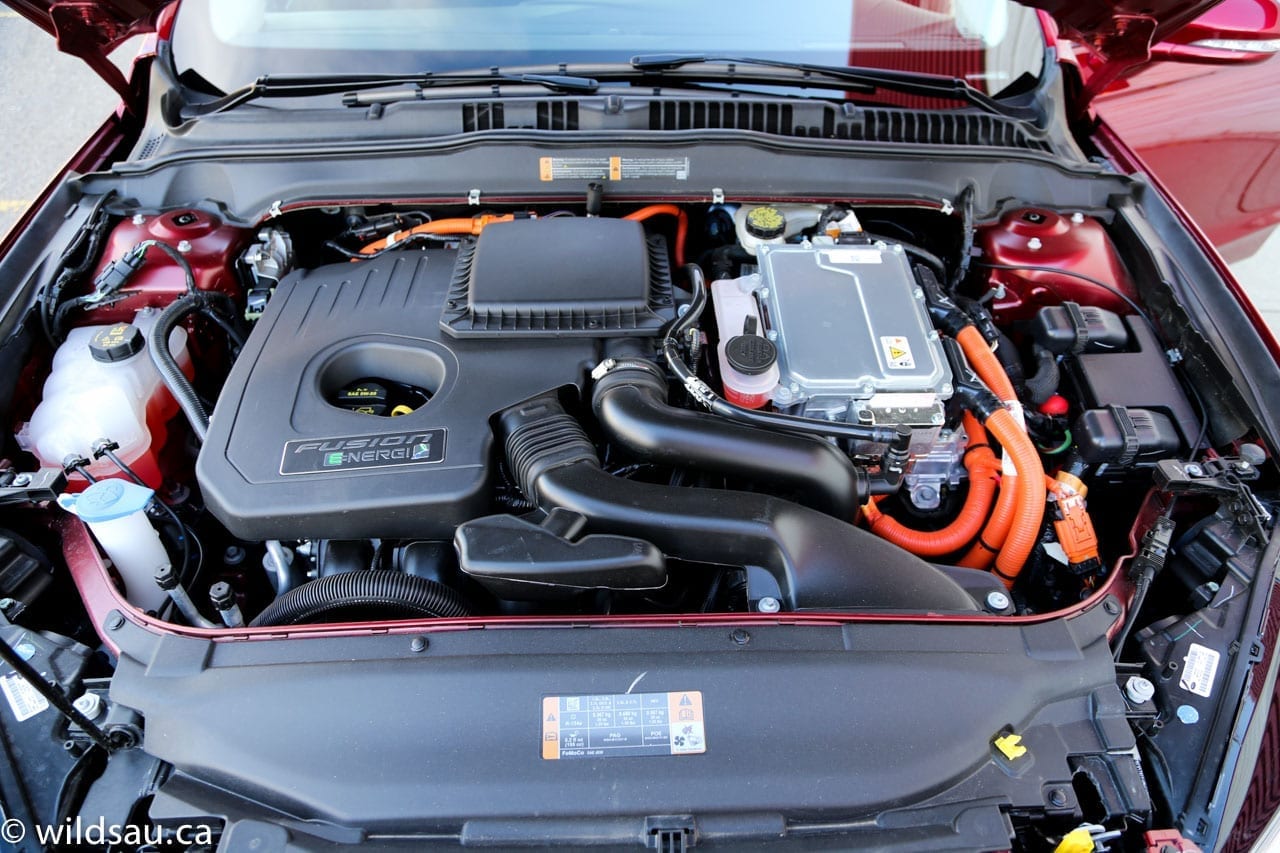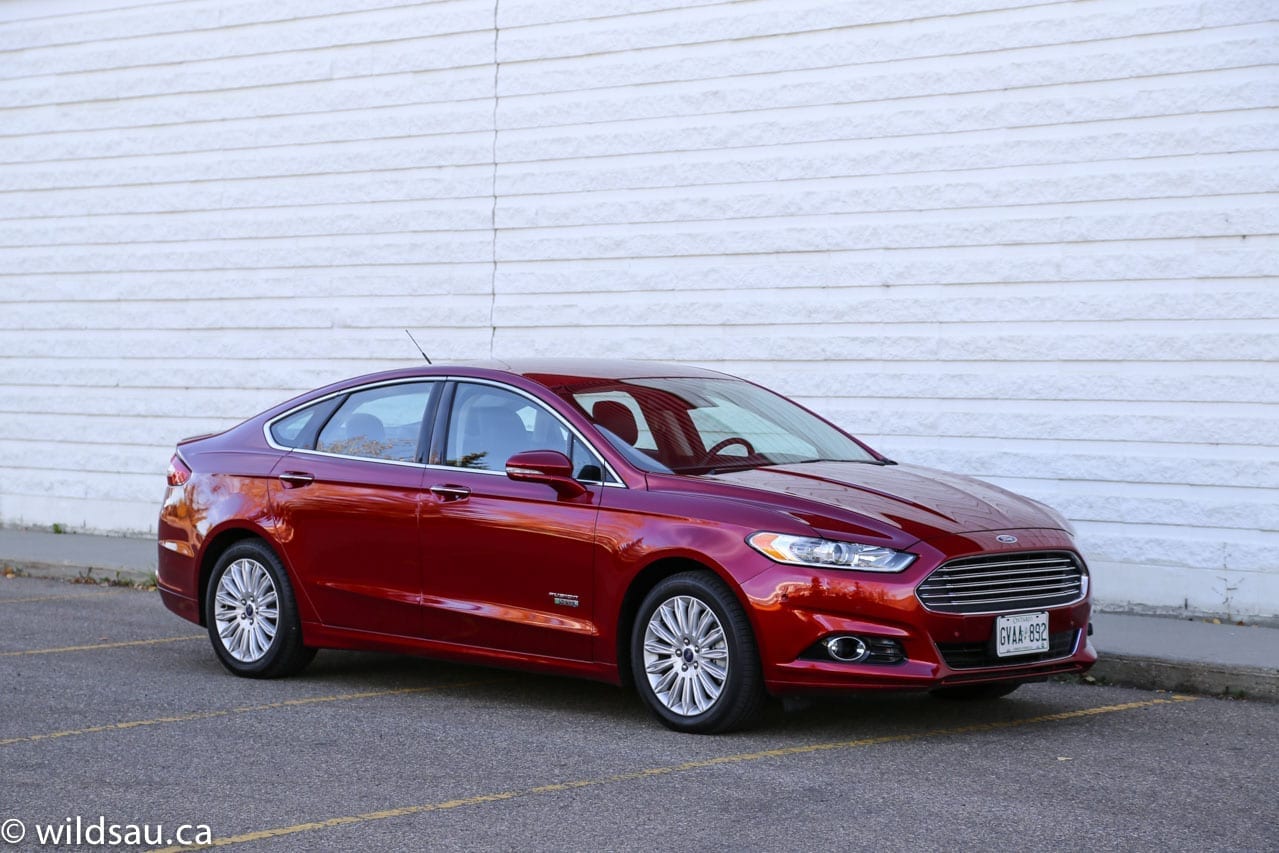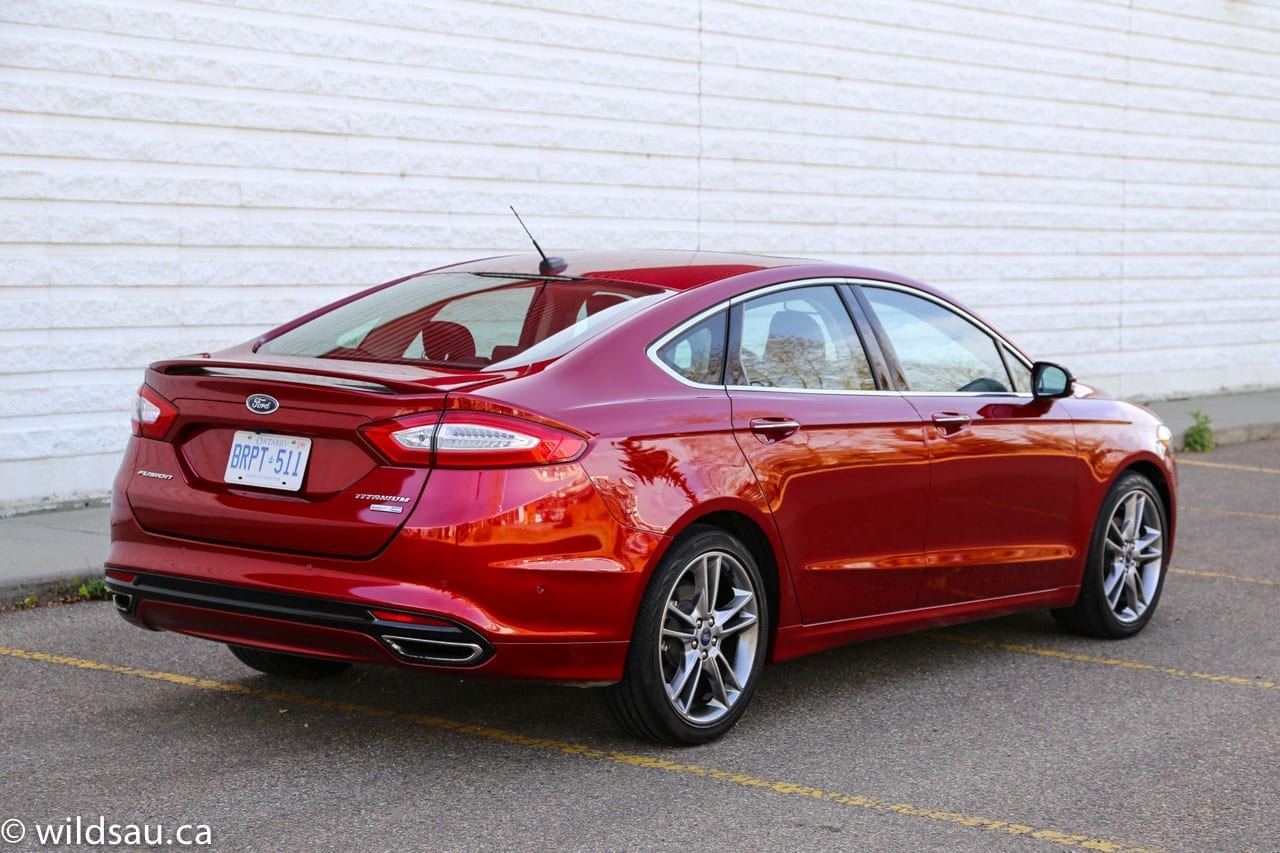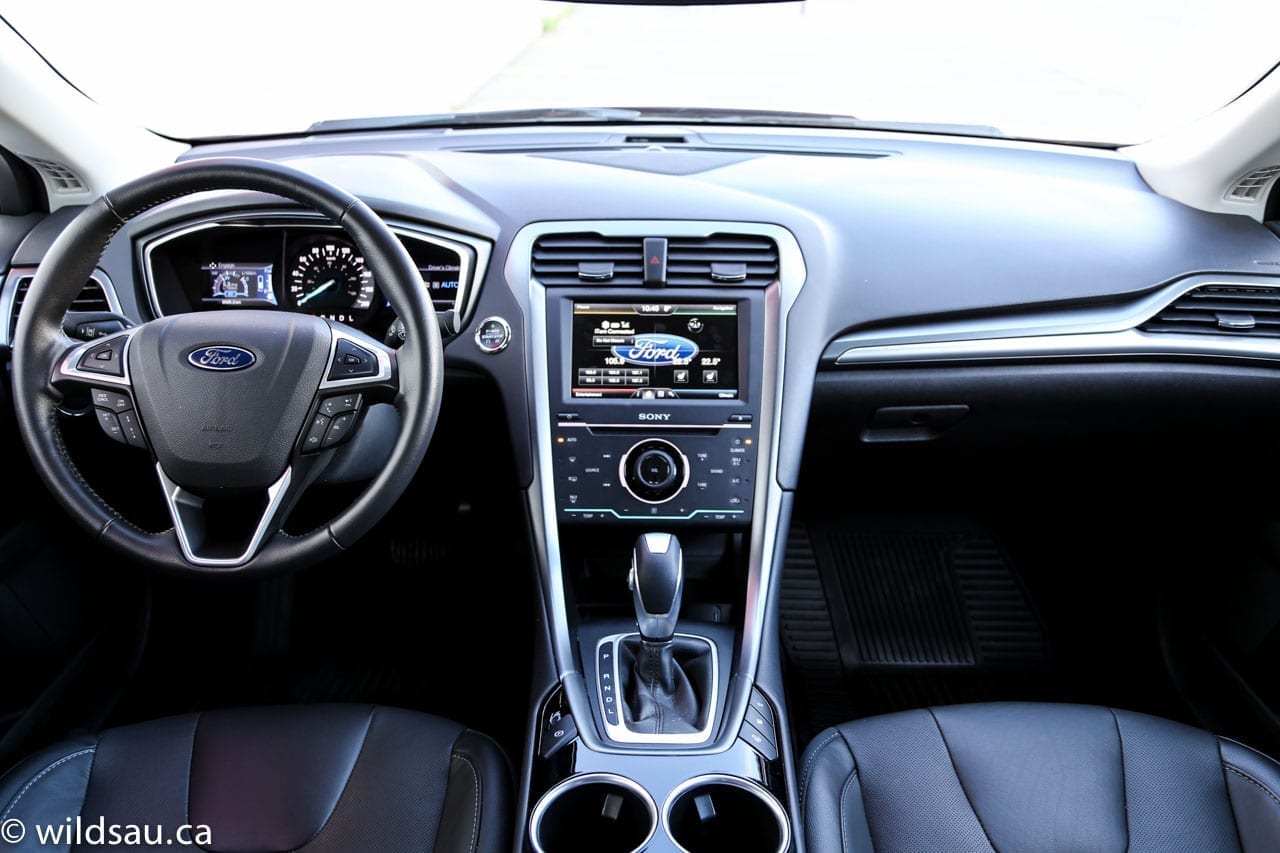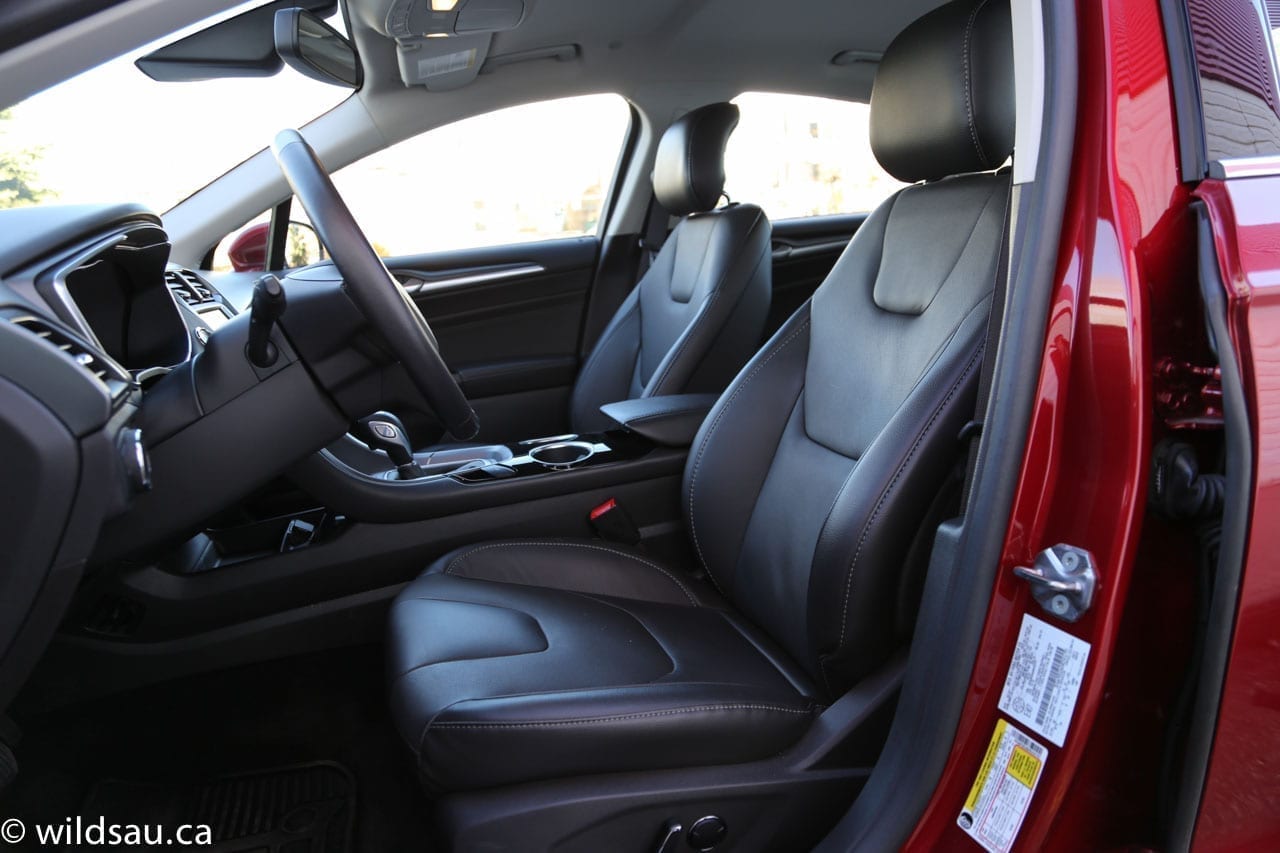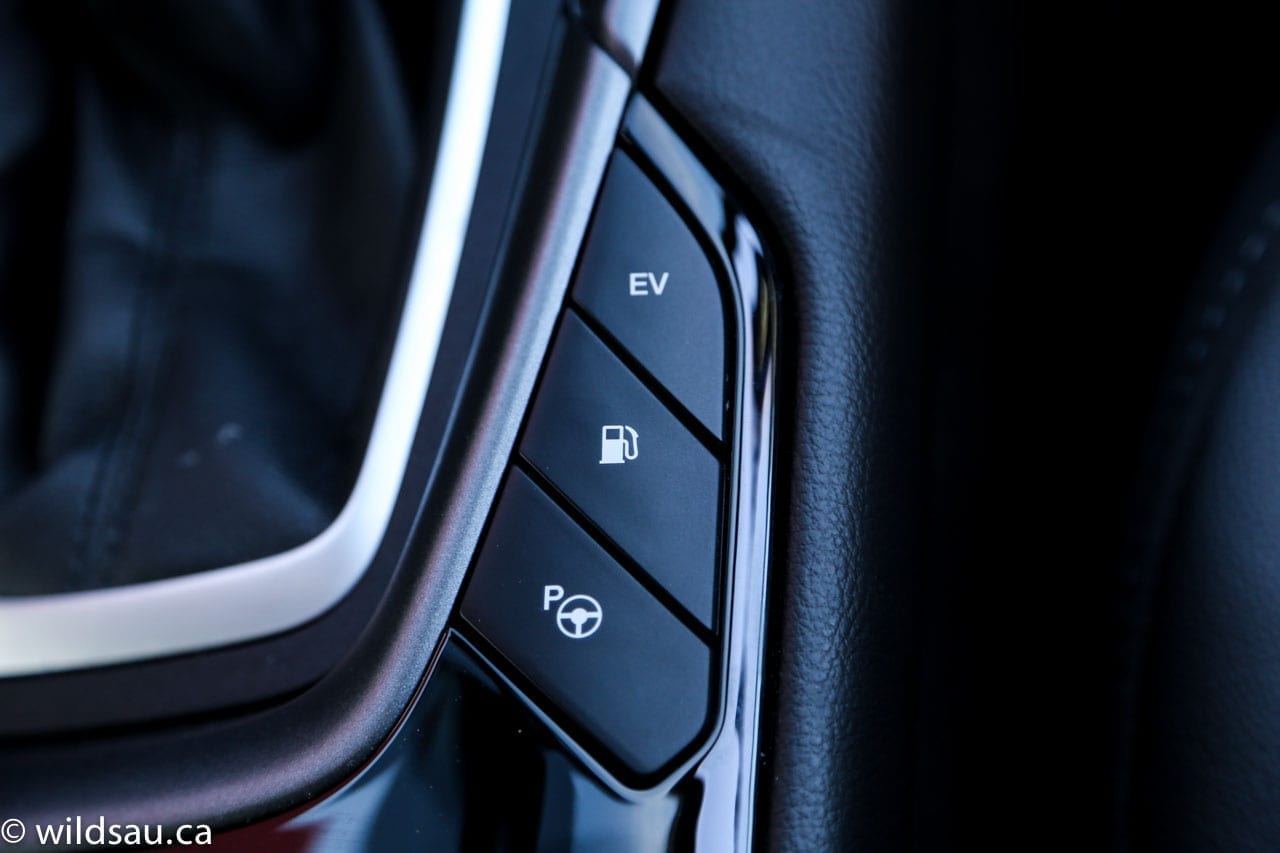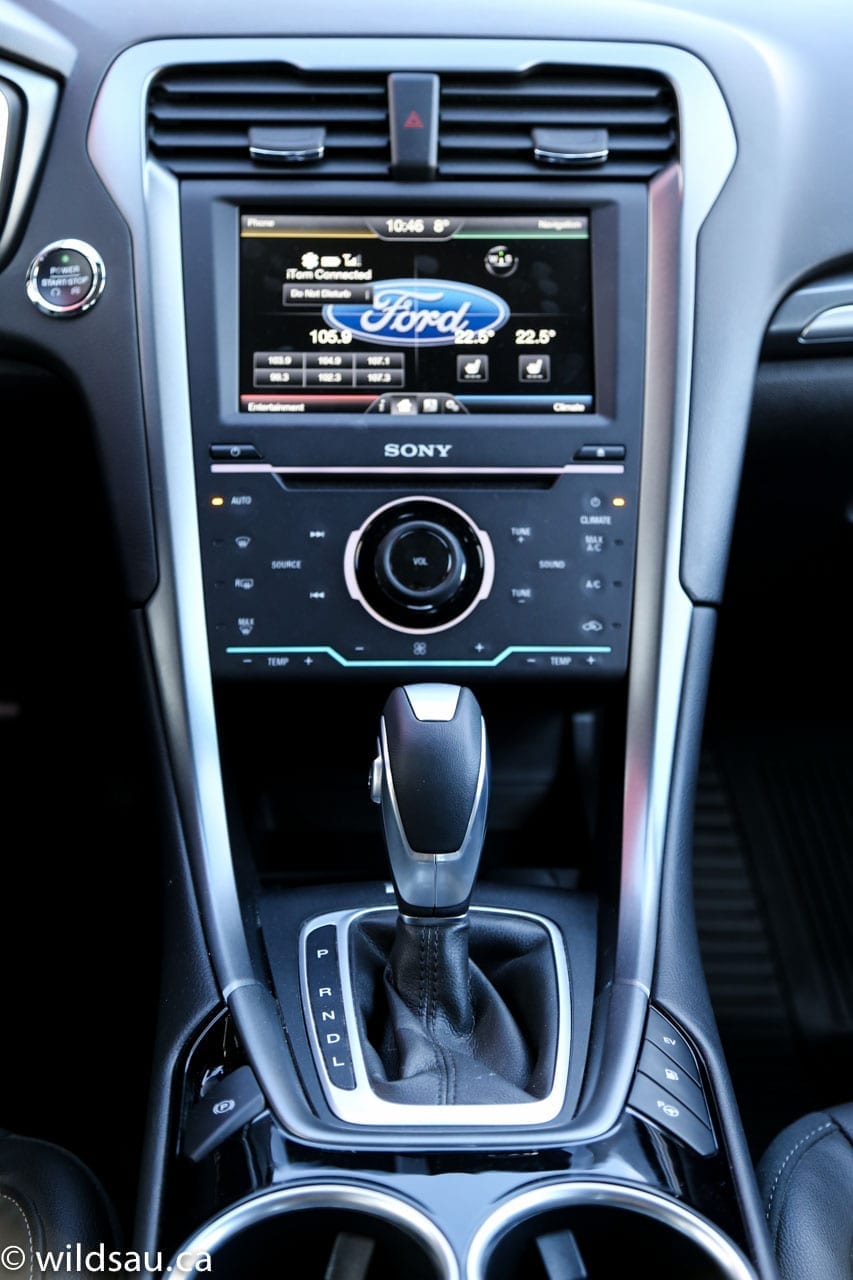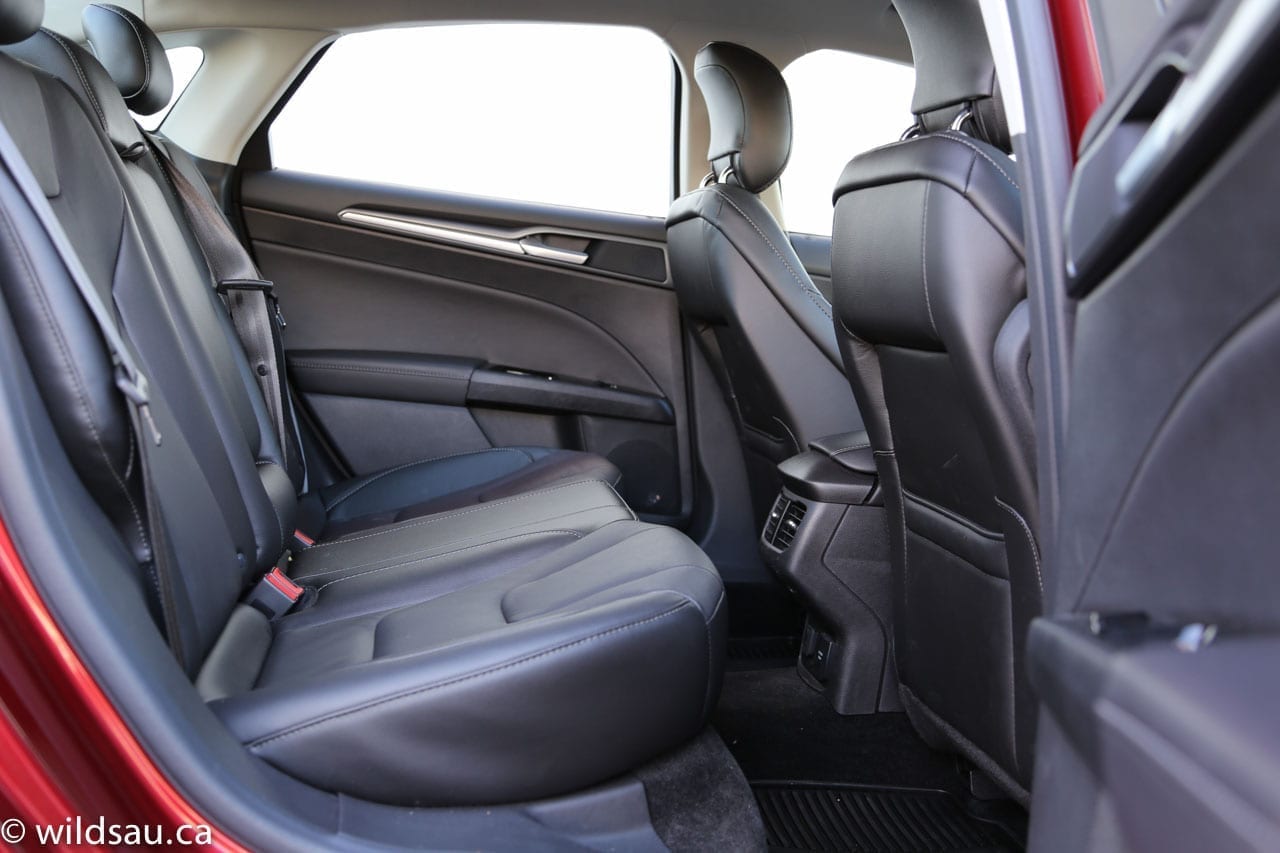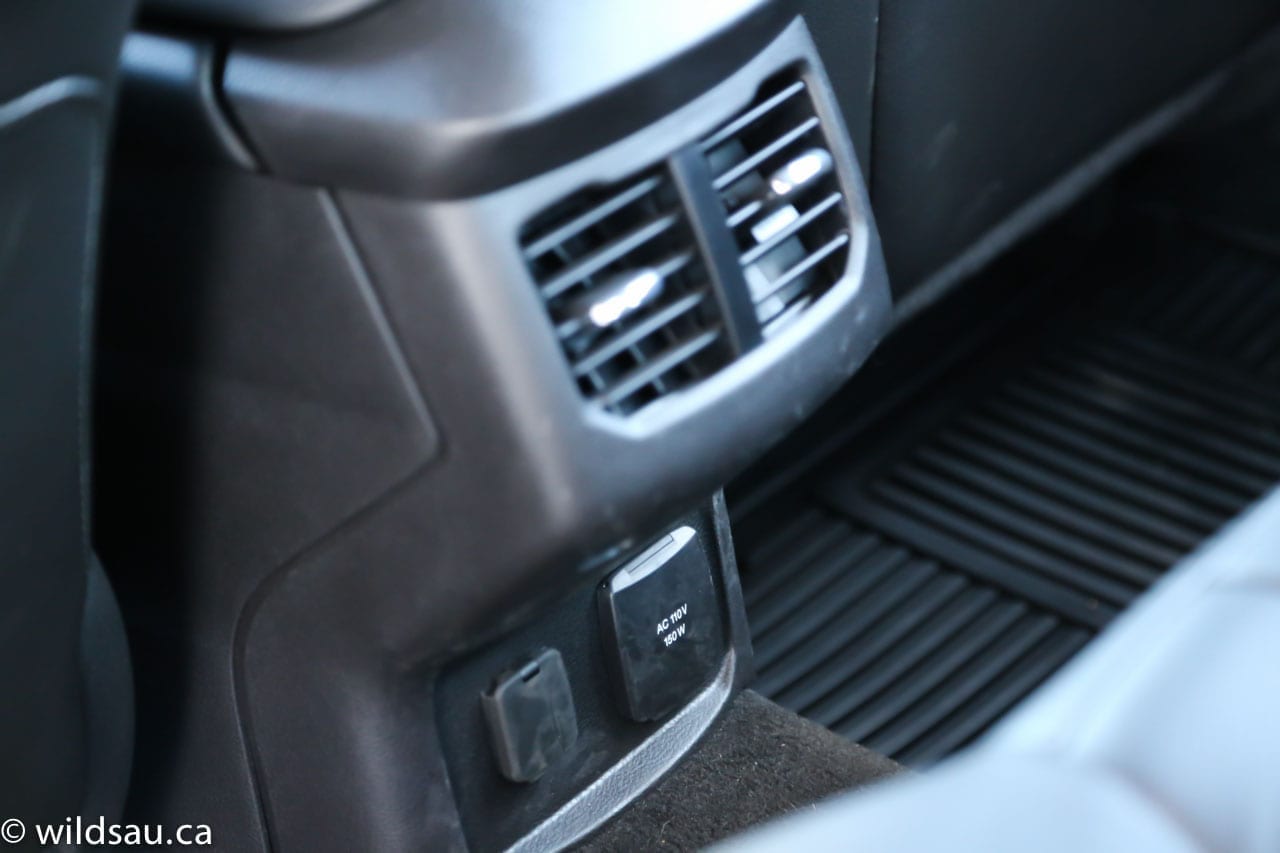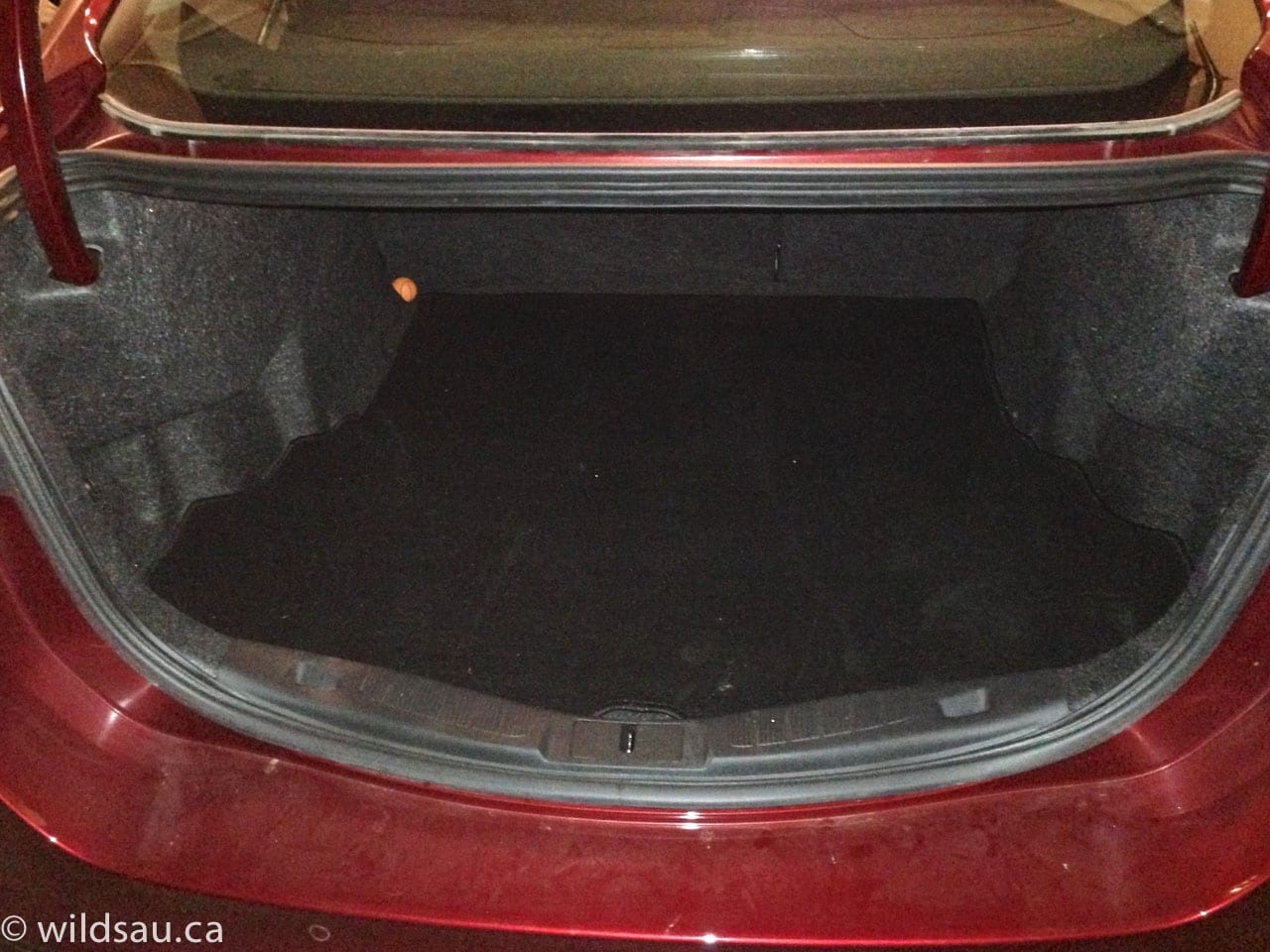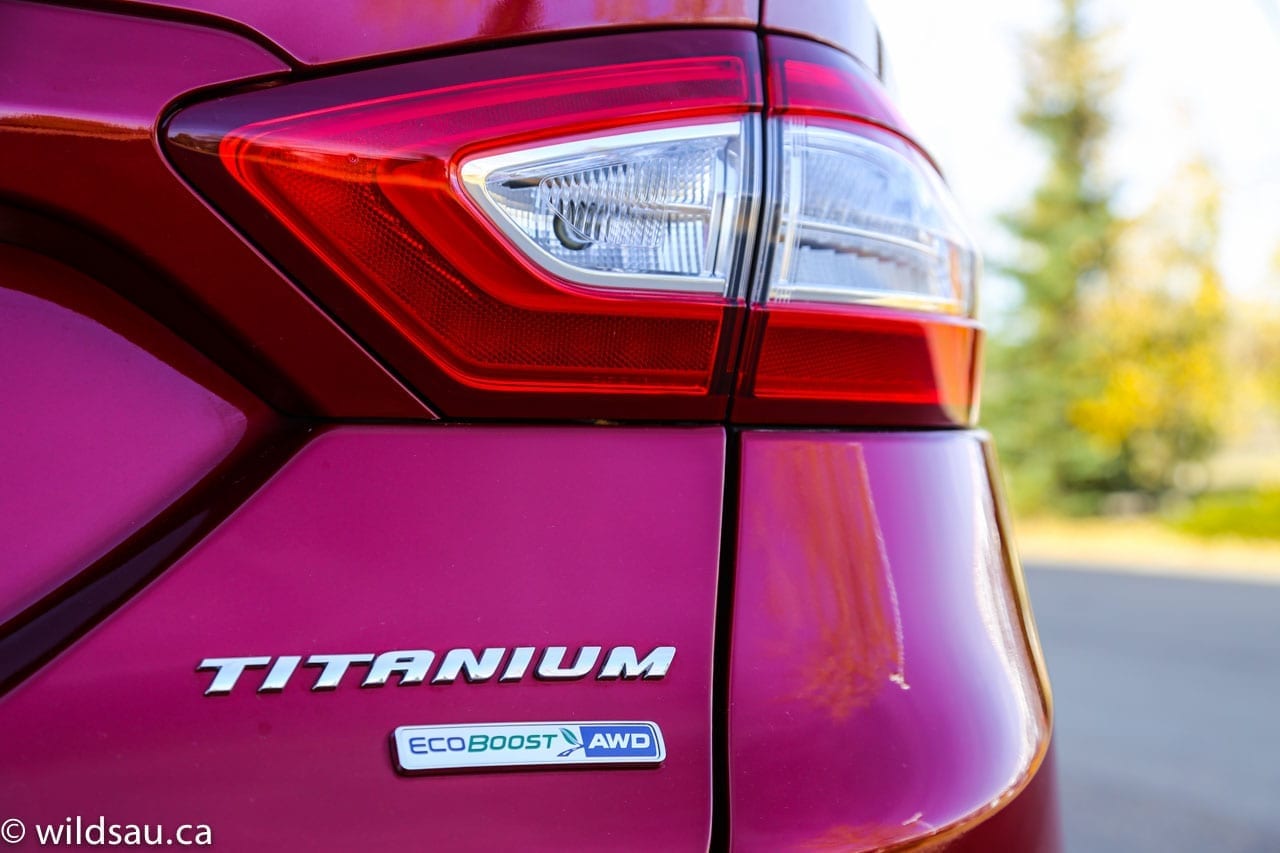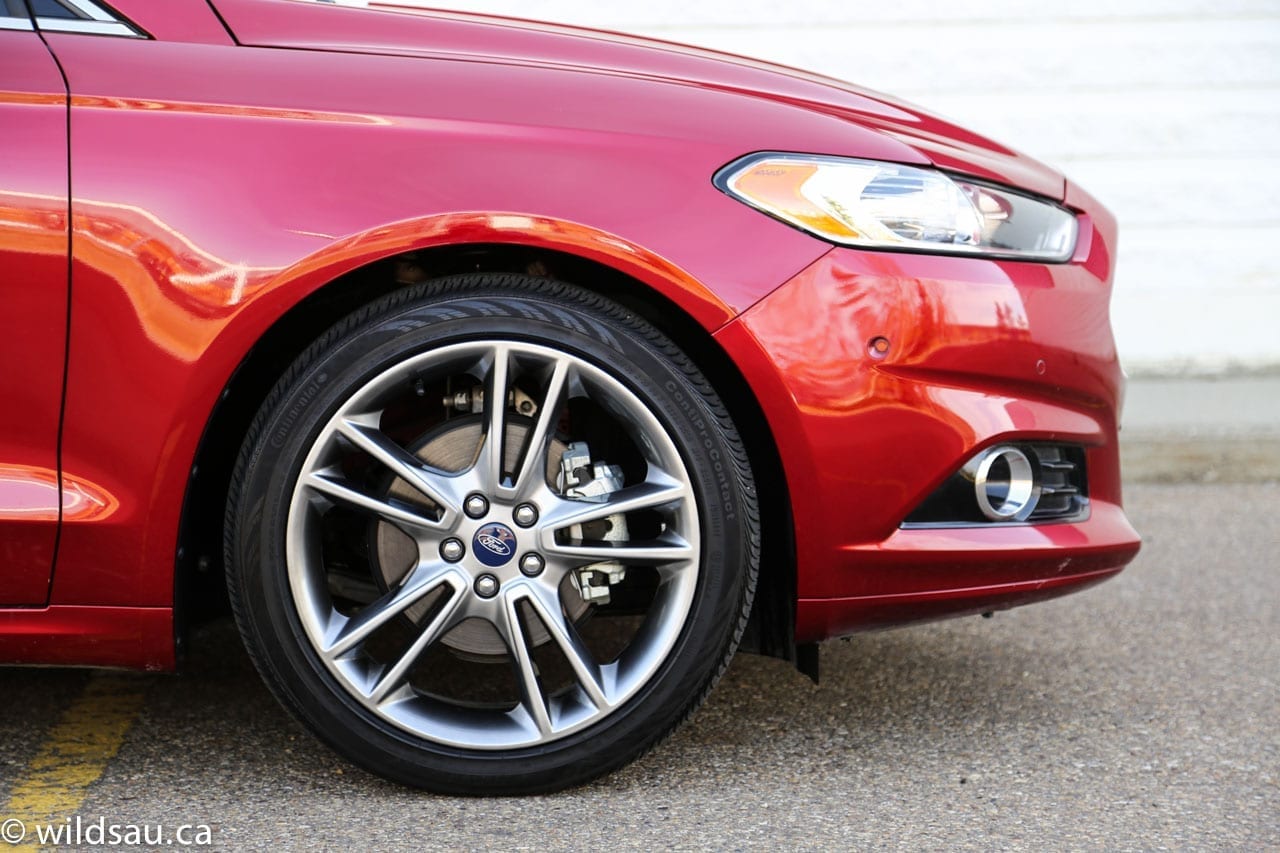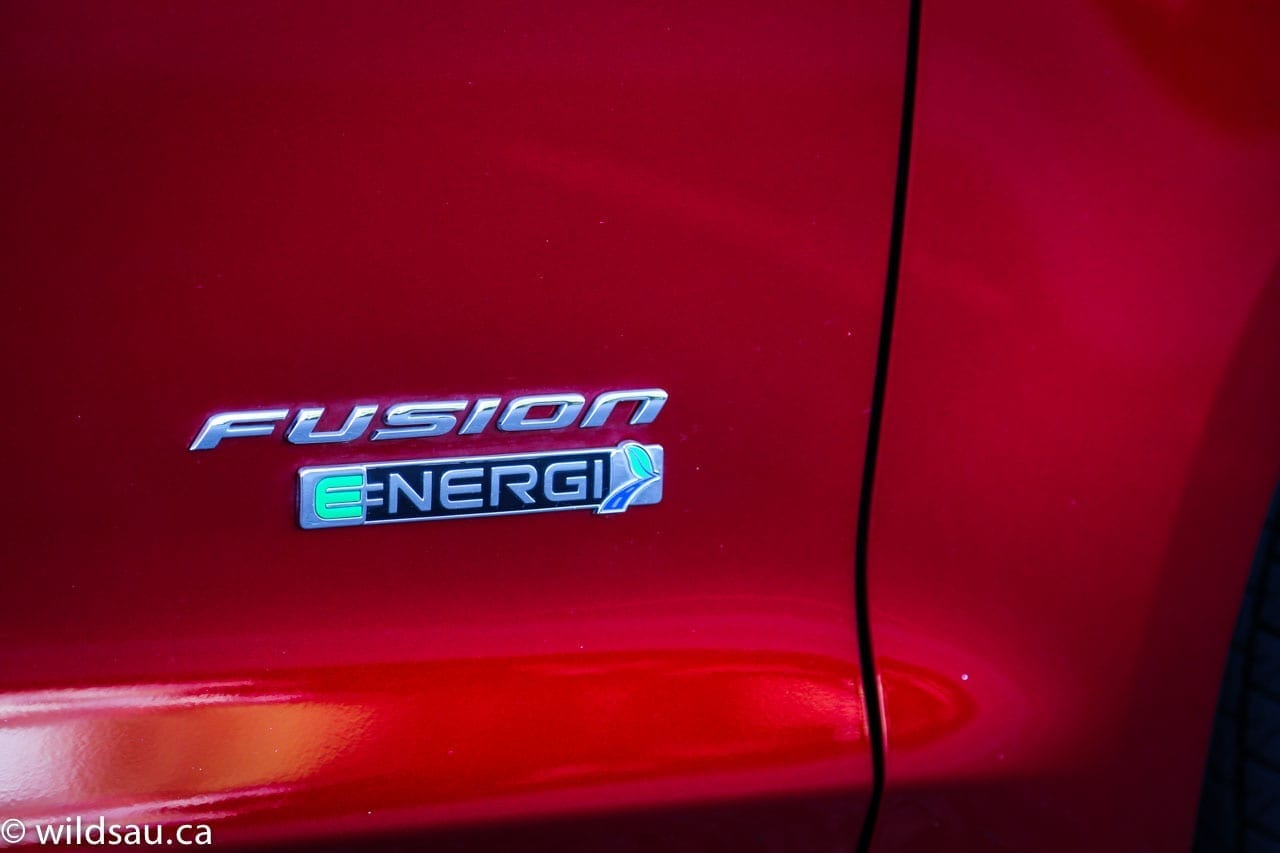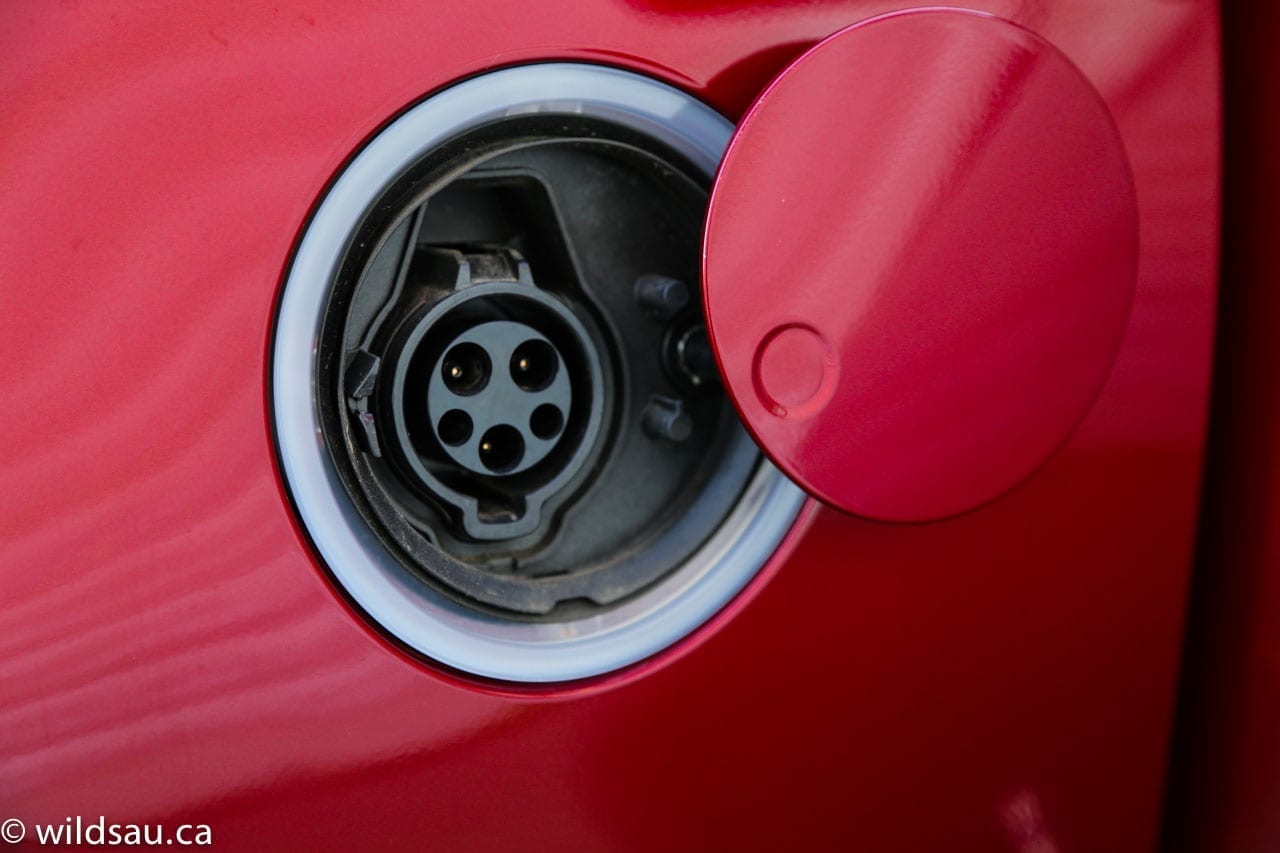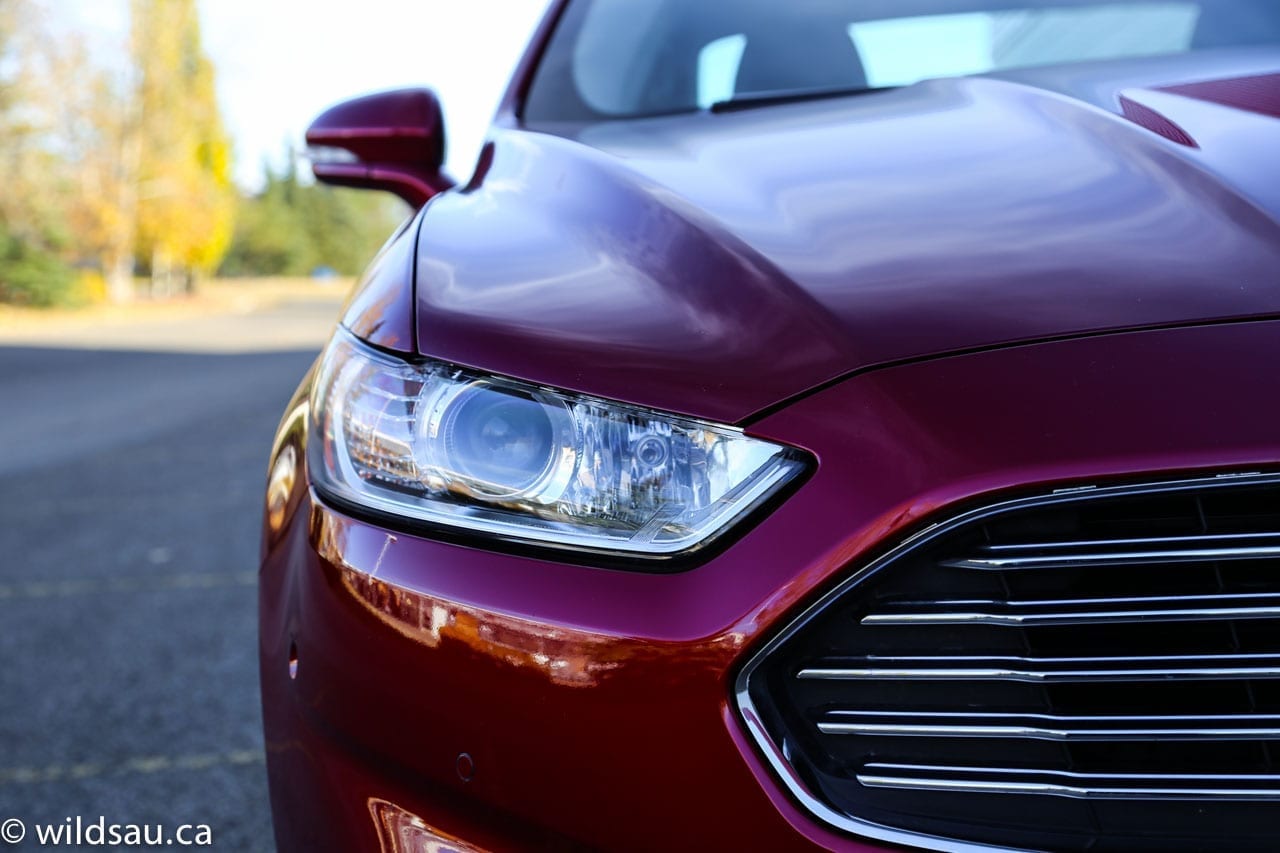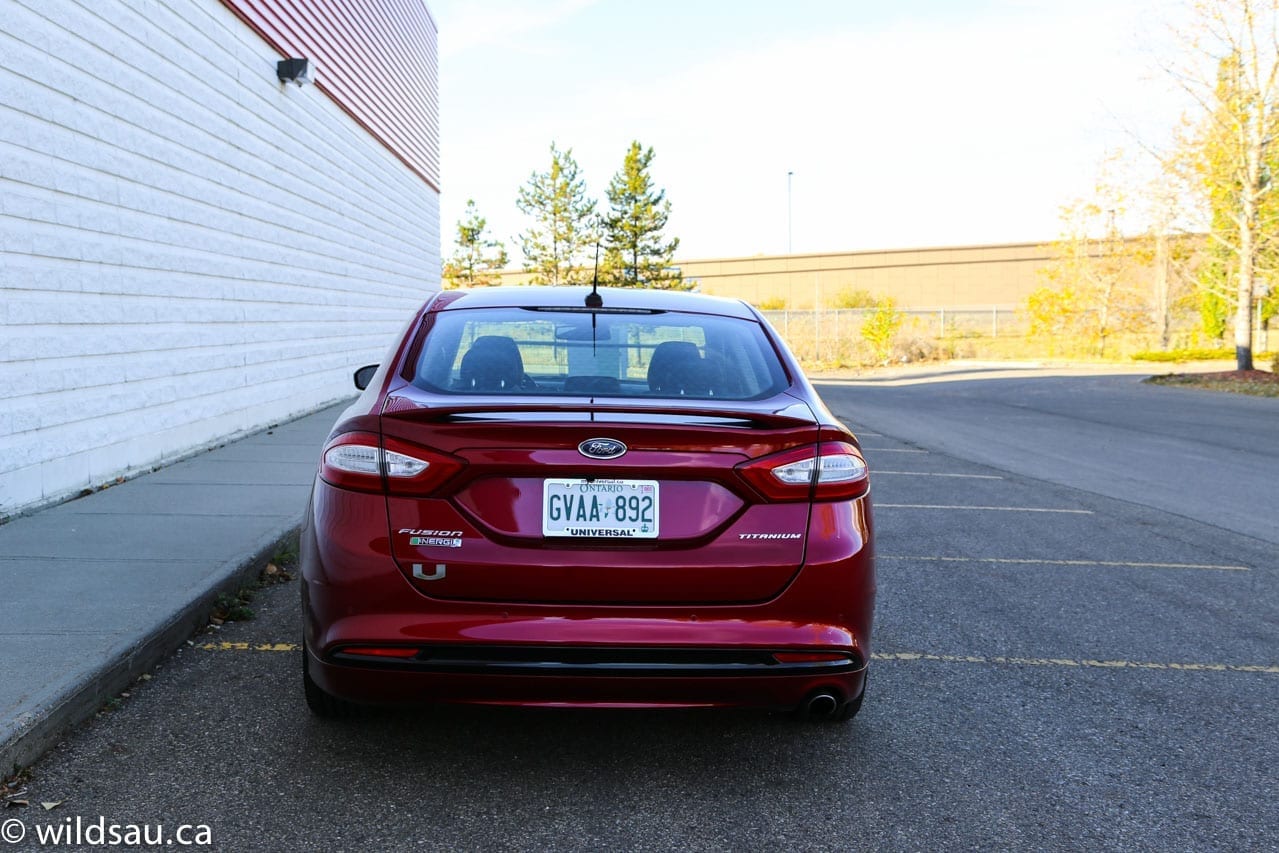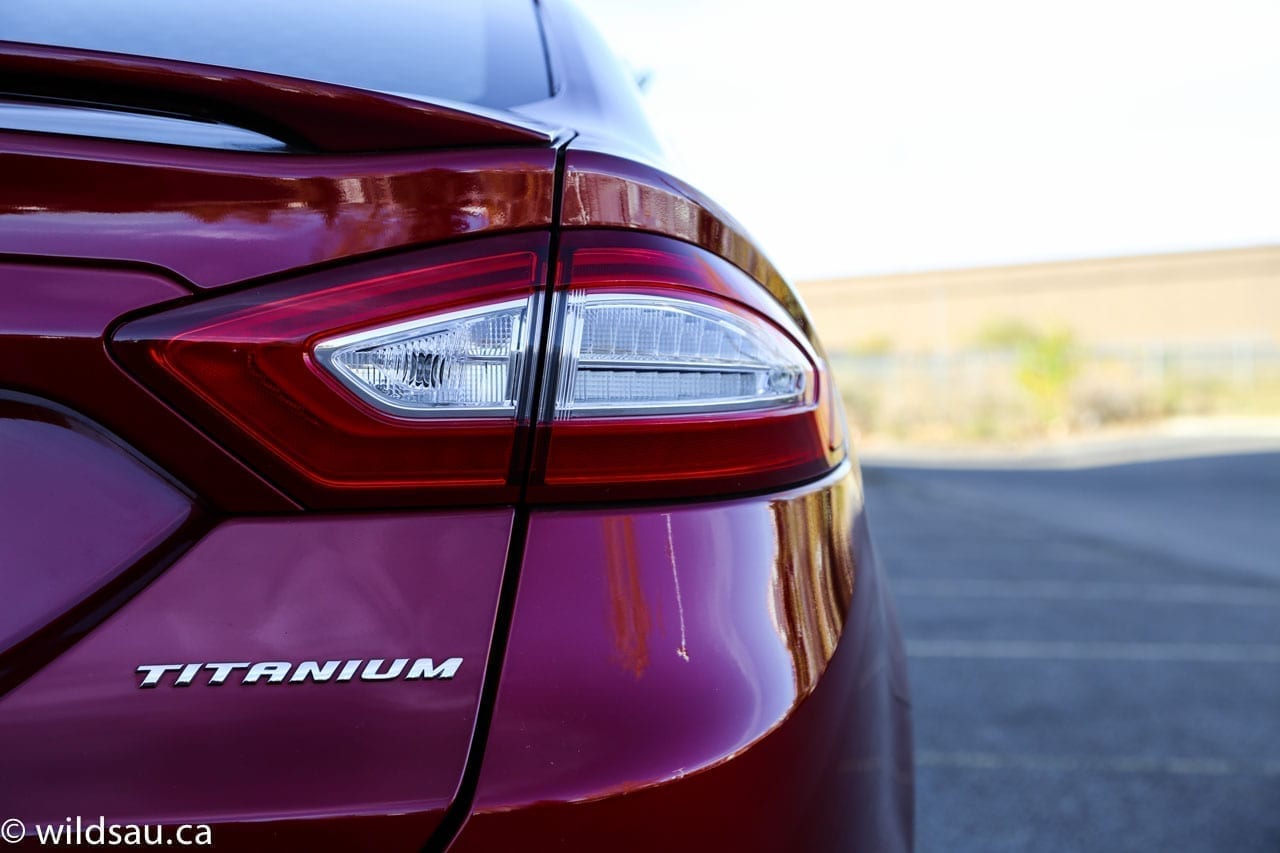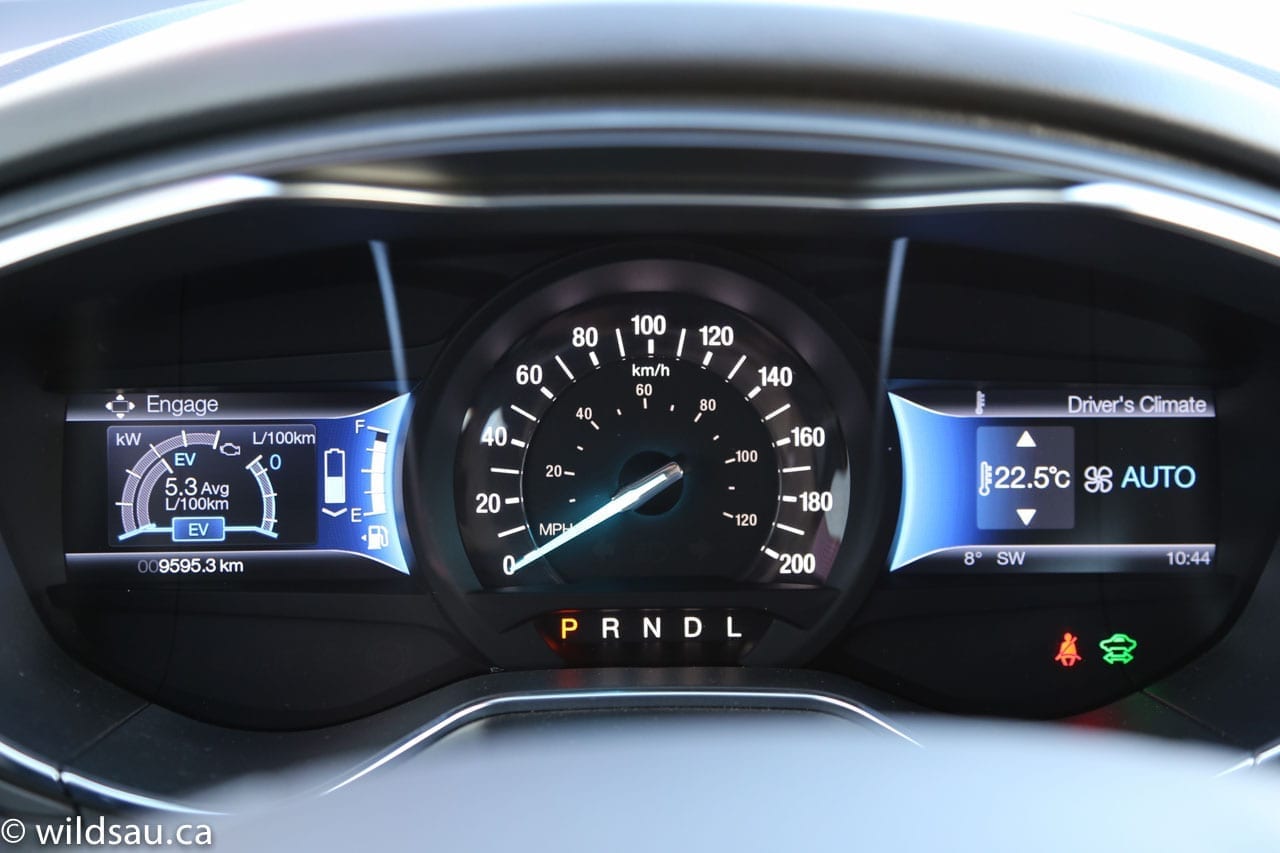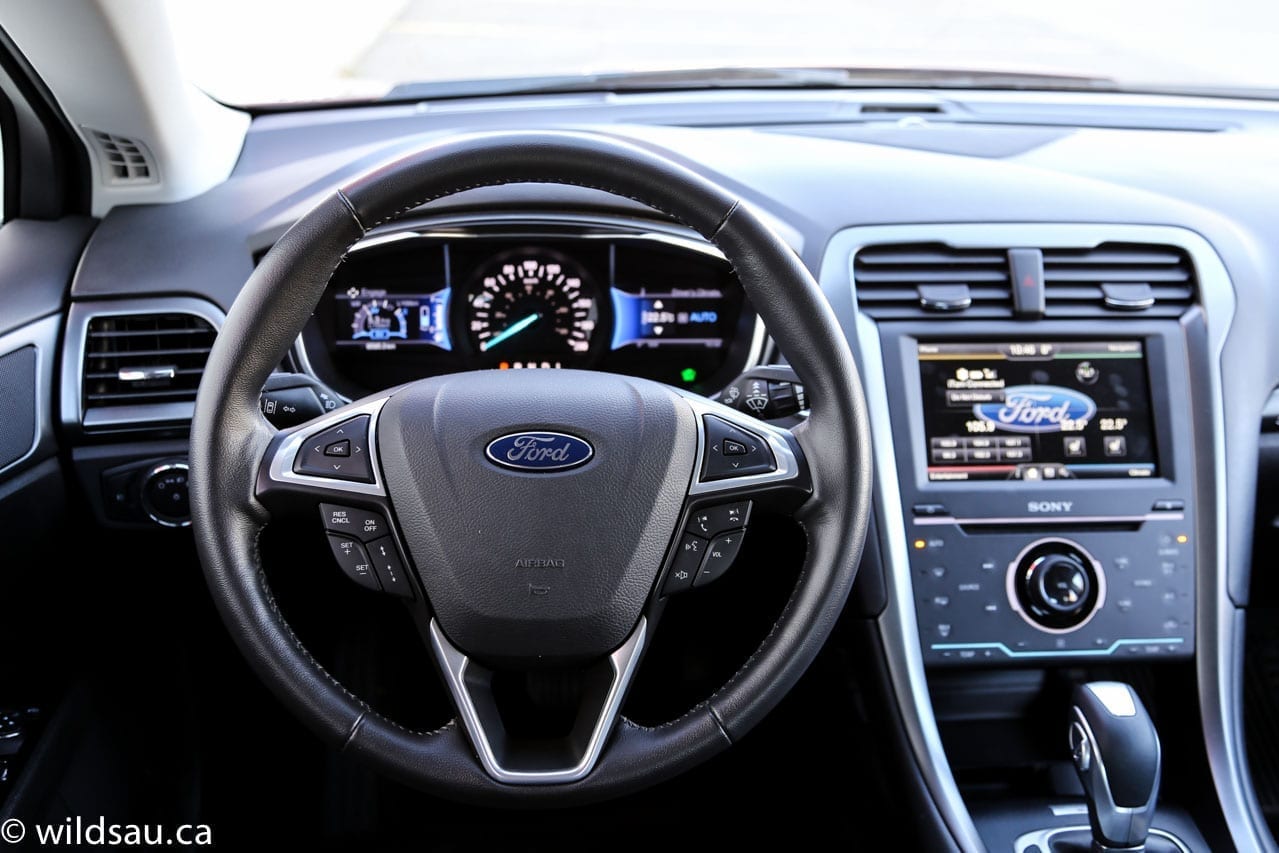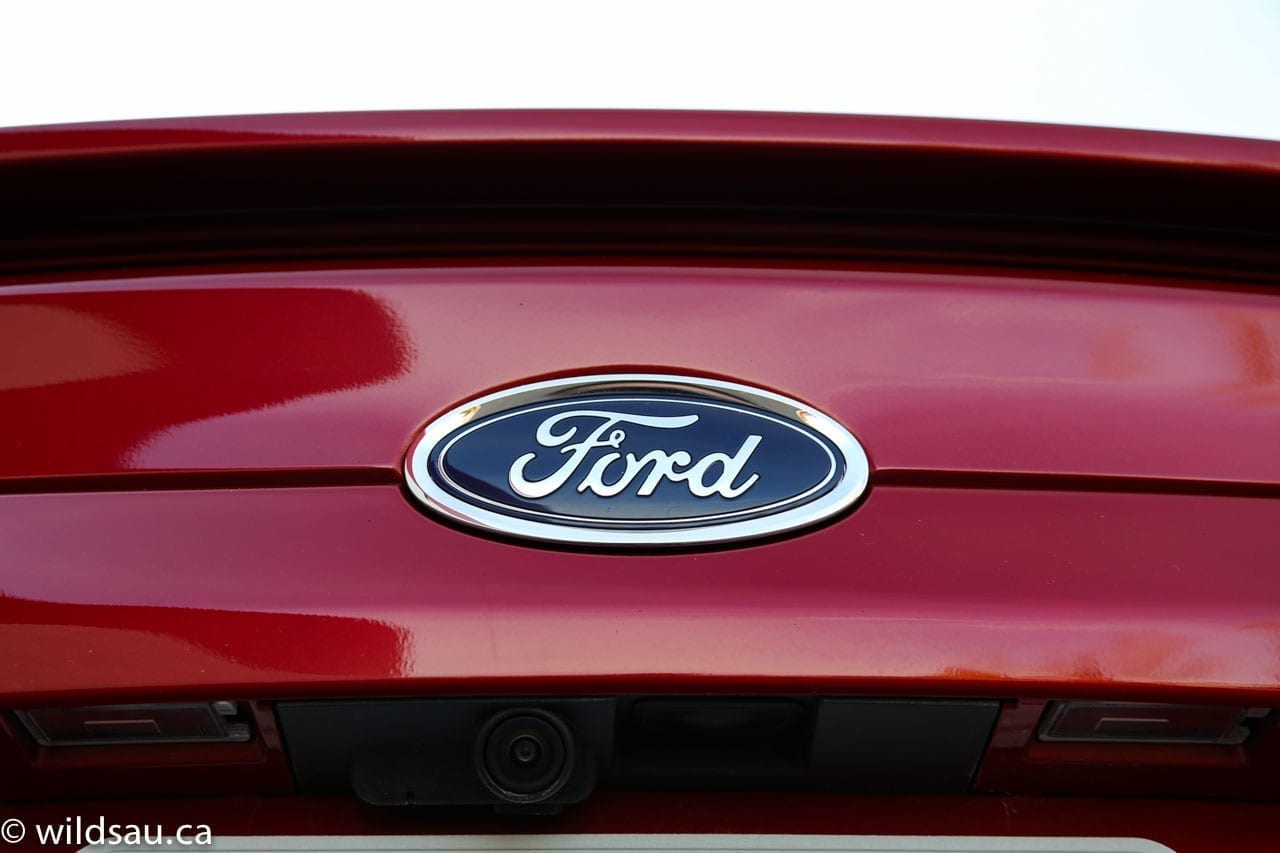I had the opportunity to review two Fusions – one after another. They were both Titanium trims, but one was the top-of-the-line gas model, the 2.0-litre EcoBoost, while the other was the Energi plug-in hybrid model. For the most part, the cars are almost identical when it comes to styling and the interiors. The big differences are under the hood, in the driving experience, at the gas pump and in the price.
Pricing: 2013 Ford Fusion Titanium
Base price (Titanium trim): $33,999
Options: $300 Ruby Red paint; $150 premium floor mats; $1250 moonroof with universal garage door opener; $600 Active Park assist; $1500 Adaptive cruise control; $700 Navigation system; $500 19″ H-spoke wheels; $1500 Driver Assist Package
Freight: $1,550
A/C tax: $100
Price as tested: $42,149
Pricing: 2013 Ford Fusion Titanium
Base price (Energi Titanium trim): $41,399
Options: $300 Ruby Red paint; $600 Active Park assist; $100 block heater; $1500 Adaptive cruise control; $150 premium floor mats; $700 Navigation system; $1450 Driver Assist Package; $40 trunk cargo net;
Freight: $1,550
A/C tax: $100
Price as tested: $47,889
Under the Hood
The Titanium gets the now-familiar 2.0-litre EcoBoost engine – a turbocharged 4-cylinder. It’s churns out 240 horsepower at 5500 RPM and 270 lb.ft of torque at 3000 RPM. The plentiful power goes through a 6-speed automatic transmission and on to an all-wheel drive system. Ford continues to market their 4-cylinder EcoBoost engines as fuel efficiency champs, all while making as much power as bigger V-6s. It’s commonly known that they’re not really that fuel efficient. The 2.0 EcoBoost Fusion is rated at 9.5 L/100 km (25 mpg) in the city, and 6.3 L/100 km (37 mpg) on the highway. Unfortunately, during normal city driving and commuting, and with two (slightly longer than my usual) highway sprints added, I averaged a not-great 11.3 L/100 km (21 mpg). I wasn’t very excited about that V-6-like mileage. The fuel tank holds 66 litres.
The Energi couples a 2.0-litre 4-cylinder running on the efficient but torque-poor Atkinson cycle with an electric motor, and puts out a total net 188 horsepower. Clearly the point is fuel efficiency. If you’ve plugged it in, you can run for a theoretical 32 km on electric mode only (the only cost being the electricity you charged the car with), and then when it’s depleted and you switch back to plain old hybrid mode, the car is rated at a combined 4.5 L/100 km (52 mpg). When I plugged it in, I was able to max out the EV mode at about 27 kilometres. While running in normal hybrid mode after I depleted the charged battery, I averaged a stellar 5.4 L/100 km (44 mpg) during normal city commuting, with a few freeway sprints thrown in. The fuel tank holds 53 litres.
Of note, my commute is about 19 km, so I can easily make it there on less than a full charge. If I had a charging station at work, I would be theoretically able to commute purely run on electric power. At about $1.50 for the energy required for me to commute to and from work (keep reading to see where I got that from), this would result in some pretty amazing energy savings over the course of a year. And of course, if you need to head on the highway, you’re left with a normal hybrid after the charge is depleted, so either way, you’re netting excellent fuel economy.
Charging can be done with a regular household plug, which would take about 7 hours. Install a 240-volt quick charge station in your garage, and you’ve got a fully charged Energi in about 2-1/2 hours. However that charger costs a significant amount of money. You can quickly see how charged the Energi is – there is a ring around the charge port that lights up blue in factors of 25 percent. So if it’s half-lit, your battery is half-charged. Alternatively, you can also check your vehicle’s stats on the smartphone app. Cool stuff. I didn’t do my own calculations, but Ford advises that, based on the average energy costs across the US, it costs approximately $1 to fully charge the car. I’m guessing it’s not that far off here.
Exterior
Simply put, the Fusion is one of (if not the) best looking sedans in this class. Ford has done a fantastic job with the styling here. Much ballyhooed is the grille, as it appears to have been ripped off of an Aston Martin. So be it. It looks good and nobody has a patent on the stretched hexagon. It’s flanked here by nice HID headlights.
But it doesn’t end there. There is real personality in that stepped hood, and as your eye traces over the steeply raked windshield and the character creases on the sides, you can’t help but think this might be the best-looking sedan Ford has built to date.
At the back, the shape nearly becomes a fastback, and led my mind to compare the rear end to the Audi A7 a couple of times. It’s that sleek. The lovely LED tail lights don’t hurt either. The Energi has a single, round exhaust tip while the gas Titanium gets two handsome integrated exhaust tips.
Both of my review samples came in a spicy Ruby Red, which glows in the shade and in the sun, and my gas model was outfitted with hot 19-inch rims.
Interior/Tech/Convenience
The Fusion’s cabin feels spacious, and has excellent head room for my 5’10” frame.
The dash is made out of soft touch texturized plastics. I was taken aback by the simple straight-forward interior styling – it’s a bit disappointing at first since it’s not very exciting but the simplicity and functionality grew on me. A bit. With that said, it is a somewhat cold, lifeless place to be – you won’t find any warmth in the black, texturized plastics and bits of silver trim.
The power-adjustable heated leather seats are comfortable and very supportive. One exception, which is relative to my own body, is that I felt the shoulder bolsters to be quite tight. I think if you had a broader back than I do, you might find these seats to be a bit restrictive in terms of their side bolstering. The driver’s side gets a 3-position memory.
There’s a decent steering wheel that has controls for media, cruise control, handsfree, phone as well as D-pads to control each of the two driver information screens. Behind the wheel is the standard Ford instrument cluster – a large centre speedometer, flanked by those aforementioned driver information screens on either side. The left side handles vehicle information like fuel economy, range, trip meters, etc. The right side displays your choice of media, phone, navigation or climate control information.
The centre stack starts with the MyFordTouch screen at the top – as always, it is split into navigation, phone, entertainment and climate control quadrants which you can tap on and drill down from there. Below it is a large flat sheet of soft buttons that worked very well – there are controls for the major functions of Sony audio system, which sounds pretty good, and for the dual-zone automatic climate control system. Again, because there are no buttons, it seems that its lacking a bit of character.
The console houses the gear selector (the gas model has a Sport mode, the hybrid has a Low mode), two cupholders and an armrest. The Energi adds two buttons, which allow you to choose which EV mode you want to drive in.
There’s a full suite of driver assistance technology – blind spot monitoring, lane keeping technology (which nudges you gently back into your lane), front end collision warning, side collision warning (great for backing out of parking spots!), front and rear parking sensors and back-up camera, adaptive cruise control and Active Park Assist. Phew! Both cars have push-start ignitions, and the gas model had a tilt-slide sunroof overhead.
Rear Seats
The back has three seats, each with a headrest and a seatbelt. I found them to be very comfortable seats, with plenty of leg room and good head room. The middle seat is the exception, as it is narrow and raised up and the center console comes back into the space – also, there’s a tunnel on the floor that the middle passenger needs to straddle.
The console has adjustable air vents, a 12V and a 120V household plug – this should be the standard in every vehicle – and you also get two seatback map pockets.
There are two sets of LATCH anchors for childrens’ seats. Our three kids were comfortable in terms of leg room, but width-wise, it was just enough to get by.
Storage
Ford has good door bins, and you get a nice sized dual-level glove compartment. There is a large bin under the armrest with USB plugs, a 12V plug and nifty organizational stuff like a pen holder, etc.
You’ll find a large deep-set open bin underneath the center stack – it has a rubberized tray and can be accessed from behind the gear selector or from either side, but it’s difficult to reach from either way – there is another 12V plug there.
The gas model’s trunk is large (453 litres) and the trunk arms are nicely shrouded so your stuff won’t get pinched under them. The Energi’s trunk, on the other hand, is minuscule at 232 litres, with the large battery pack taking up most of it. It’s significantly smaller than the regular car’s trunk. You can get a grocery trip’s worth of stuff in there fine, but picking up people from the airport or heading out on a road trip could definitely become a problem.
The Drive
Both Fusions have a solid, upscale feel on the road.
Both has decent get-up-and-go power. Obviously the EcoBoost has more of it, but I was pleasantly surprised by how torquey and gutsy the Energi’s drivetrain was. It has more than enough power for everyday driving in every situation – off the line (0-60 in 8.6 seconds in hybrid mode!) and while on the go.
The gas model’s 6-speed transmission is smooth, and relatively intelligent. It can be shifted manually with paddles, and there is a sport mode. The Energi gets a CVT, which does a decent job as well. Yes, it acts as most CVTs do, and when the gas engine revs up a bit, it does drone a bit but it’s not intrusive.
I noted the EV-modes in the Energi – it allows you to choose when you use the battery’s charge. If you’re headed for the highway, you’ll benefit less from electric power, so you can save it there, and choose to use it when you get into more bumper-to-bumper, slower driving, where you’ll see the most gains from the electric drivetrain.
The new Fusion’s ride is very refined – it’s supple, but very well controlled and has the perfect amount of firmness. The suspension soaks up big hits and keeps the cabin mostly isolated from them, and the structure feels very stiff and rigid. The word “solid” keeps coming to mind.
In addition, the handling is excellent – I found the electronic steering to be surprisingly sharp and the Fusion’s turn-in is great, which makes the car feel quite agile. Yes, there’s a little bit of body roll but it always feels planted and willing. The Energi is heavier because of the battery pack, and you can feel that on the road.
The Titanium’s brakes are powerful, but the Energi’s are typically hybrid-spongy. It feels like the brake lines are filled with Slurpee, and the brake feedback is poor. Also, Ford chooses to constantly nag at you with the Braking Coach, telling you how much you suck at efficient regenerative braking on the little driver information screen.
I found both models to be quiet – road, wind and drivetrain noises are very well controlled. Visibility out of the car is decent. The rear window is a bit tight, and the headrests cut into it a bit, but overall, it’s fine.
Nitpicks
I took issue with the somewhat small trunk opening, which could hamper access on occasion.
And when on a bluetooth-connected phone call, a strange whining sound kept coming from the speakers during almost every conversation – very noticeable and very annoying.
The Verdict
Ford has put together a very solid, upscale-feeling sedan with the Fusion. It has to compete in a very tight class, where the players have all upped their game and are all fighting for their piece of what seems like a shrinking pie with so many consumers moving to crossovers these days.
Regardless, the Fusion is a serious piece of kit. The engine choices are plentiful – other than the 2.0 EcoBoost and plug-in hybrid I drove, you can still opt for a 1.6 EcoBoost or a non-plug-in regular hybrid. And in many trims, you can choose between front- and all-wheel drive. It’s an ambitious vehicle, offering plenty of price points and plenty of goodies.
I liked the exterior styling but wasn’t very excited about the clinical, stark interior (though it works well). The technology in these loaded up models is dizzying, between all the included entertainment, luxury and driver assistance tech. Performance is good, and the car feels very well put together.
I give the Fusion Titanium a 7.5 out of 10, and the Fusion Titanium Energi a 7 out of 10 (I drop my personal rating because it’s just too expensive for me).
WAF (Wife Acceptance Factor) was pretty good. She dug the exterior and actually didn’t mind the interior’s simplicity, stating it worked well for her. She liked the size of the car, saying it wasn’t too big or too small, easy enough to park and with enough trunk space. Her final thought was “I liked it, but I didn’t love it”.
As I said, the Fusion has to compete with a category that’s imbued with greatness, as nearly every offering in it is a great vehicle in its own right. But it does a good job being competitive, bringing an enjoyable drive, a (potentially) feature and tech-loaded cabin and delightful styling to the table.
Disclosure: Vehicles were provided by Ford Canada.
If you enjoyed this review, feel free to check out my other vehicle reviews under the car reviews tab at the top of my blog.



